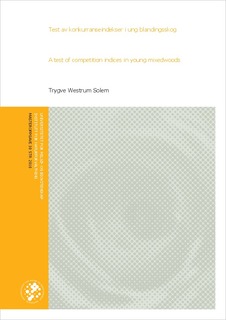| dc.description.abstract | Oppgaven hadde som mål å teste ut et utvalg enkle konkurranseindekser i ung blandingsskog. Kunnskap om økologisk konkurranse mellom individuelle trær er et nyttig hjelpemiddel blant annet i forbindelse med planlegging og fremskriving av skog. Det ble utført registreringer i to ungskogsbestand i Ås kommune i det sørøstlige Norge. Begge bestandene besto av et nedre sjikt av gran (Picea abies), og et øvre sjikt av hovedsakelig bjørk (Betula pubescens og Betula pendula). Hvert enkelt tre ble kartlagt, og det bel registrert data om både høyde- og diametertilvekst. Fem tradisjonelle konkurranseindekser ble testet ut, i tillegg til en sjette konkurranseindeks som ble tatt med for å representere underjordisk konkurranse om vann og næringsstoffer. Potensiell tilvekst ble beregnet som en funksjon av utgangshøyde/utgangsdiameter. Forventet tilvekst ble beregnet som potensiell tilvekst begrenset av en eller flere konkurranseindekser. For høydetilvekst ble best resultat oppnådd med diameter/avstand-konkurranseindeks i kombinasjon med underjordisk konkurranseindeks (R2Adj : 0,8948). For diametertilvekst ble best resultat oppnådd med konkurranseindeks basert på vinkelsum av konkurrenttrær, i kombinasjon med underjordisk konkurranseindeks (R2Adj = 0,9060). Overjordisk konkurranse hadde størst betydning i bestand 1, mens underjordisk konkurranse hadde størst betydning i bestand 2.
The aim of this study was to test the predictive value of a selection of simple competition indices in young mixed stands of Norway spruce (Picea abies) and birch (Betula pubescens and Betula pendula). Knowledge of ecological competition between individual trees can act as a helpful tool in forest planning and for predicting future growth. Field measurements were made in two young stands located i Ås municipal in the south-eastern part of Norway. Both stands were made up of a two-storied mixture of Norway spruce under a shelter of mainly birch. Field measurements included tree coordinates, and measurements of height- and radial increment. Five well known competition indices were selected for testing, in addition to a sixth competition index which was intended to represent competition for belowground resources like water and nutrients. Potential increment was described as a function of initial height/diameter. Expected increment was then described as potential increment limited by one or more competition indices. Best results in predicting height increment was achieved with a competetition index based on dbh-ratio weighted by distance, combined with the belowground competition index (R2Adj= 0,8948). For radial increment, best results was achieved with a competition index based on the sum of the horizontal angels of the competitors, combined with the belowground competition index (R2Adj=0,9060). Aboveground competition was most pronounced in stand 1, while belowground competition seemed to be of most importance in stand 2. | en_US |
